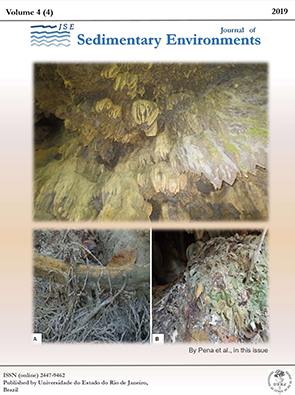THE IMPRINT OF THE GEOLOGICAL INHERITANCE AND PRESENT DYNAMICS ON URUGUAYAN INNER SHELF SEDIMENTS (SOUTH-WESTERN ATLANTIC)
DOI:
https://doi.org/10.12957/jse.2019.47021Keywords:
Sedimentary dynamics. Hydrographic dynamics. Río de la Plata estuary. South-western Atlantic. Inner shelf.Abstract
The Uruguayan continental shelf is characterised by a unique hydrographic system, composed of the Río de la Plata buoyant plume (RdlP-BP), and by water masses of contrasting thermohaline characteristics. Below the RdlP-BP the southward-flowing Subtropical Shelf Water and the northward-flowing Subantarctic Shelf Water converge at the Subtropical Shelf Front, which is the shelf extension of the Brazil-Malvinas Confluence. Three main sedimentary environments can be described associated with; I) “Atlantic coastal sands” (i.e. onshore from the palaeovalley); II) the SW-NE running “RdlP palaeovalley” and; III) “Relict sands” (i.e., offshore of the RdlP palaeovalley). Three exposed sedimentary units (U1 to U3) identified from acoustic profiles and sediment cores (sedimentary characteristics of stratigraphic units) almost entirely restricted to the palaeovalley. The transect here studied intersects these three environments contributing thus with the description of the morphological setting and sedimentary coverture. Physical and geochemical data were integrated and used to characterise the sedimentary facies previously described in the inner shelf and to understand environmental control on the development of these facies.
Sediments from U1 show the terrestrial imprint of the RdlP and drier regional conditions, while sediments that characterised U3 indicate a sandy facies (quartz and bioclasts: whole and fragmented shells and polychaetes tubes) corresponding to an ancient coast. This last (with approximately 11 m height), is probably related to sea-level stabilization, between 20 and 25 m occurring during the Upper Pleistocene and Holocene for the South-Western Atlantic. The sediment from U3 reflects the colder and drier conditions prevailing in the region during the formation of this facies (13.7 and 9.7 cal ka BP). Eroded sediments (e.g., from U3; ancient coast) are deposited inside the palaeovalley and on the onshore region (between the palaeovalley and coastal sands). Also, U1 extends from the palaeovalley covering the onshore region. The outcrop of warmer oceanic shelf waters was probably a consequence of the geomorphology of the palaeovalley (edge of the palaeovalley) and related to the still fall presence of waters typical of the austral warm season when higher advection of Brazil Current occurs over the shelf. In this regard, the mound-like feature should induce bottom water to rise, operating as a ramp. Productivity proxies (Si/Ti, Ba/Ti, Ca/Ti and P/Ti) present the highest values in these stations (S16-S18), reflecting the imprint of the upwelling in the sediment.
The information reported in this work is particularly important to better understand sedimentological dynamics in the Uruguayan inner shelf and the Southwestern Atlantic region. It is also important for elaborating more precise paleoenvironmental and palaeoceanographic reconstructions.
Resumo
A plataforma continental uruguaia é caracterizada por um sistema hidrográfico único, composto pela pluma túrbida do Rio de la Plata (RdlP-BP) e por massas de água com características termohalinas contrastantes. Abaixo da RdlP-BP, a água subtropical da plataforma que flui para sul e a água subantártica da plataforma que flui para norte convergem para a frente subtropical da plataforma, a qual é a extensão da Confluência Brasil-Malvinas.
Três principais ambientes sedimentares podem ser descritos associados: I) a "areias costeiras atlânticas" (com ocorrência em direção a terra a partir do “Paleovale do RdlP”); II) o “Paleovale do RdlP” com direção SW-NE e; III) a "Areias relíquia" (para offshore do “Paleovale do RdlP”). Três unidades sedimentares estratigráficas expostas (U1 a U3) identificadas a partir de perfis acústicos e testemunhos de sedimentos quase que totalmente restritas ao paleovale. Dados físicos e geoquímicos foram integrados e utilizados para caracterizar as fácies sedimentares encontradas na plataforma continental interna e para entender o controle ambiental sobre o desenvolvimento dessas fácies.
Os sedimentos da unidade U1 representam o registo terrestre da RdlP e condições regionais mais secas, enquanto os sedimentos que caracterizam a unidade U3 indicam fácies arenosas (quartzo e bioclastos: conchas inteiras e fragmentadas e tubos de poliquetas) correspondente a uma costa antiga. Este último (com aproximadamente 11 m de altura) está provavelmente relacionado à estabilização do nível do mar, entre 20 e 25 m durante o Pleistoceno Superior e o Holoceno, no Atlântico Sudoeste. O sedimento da unidade U3 reflete as condições mais frias e secas da região durante a formação desta fácies (entre 13,7 e 9,7 cal ka BP). Sedimentos erodidos (por exemplo, de U3; costa antiga) são depositados dentro do paleovale e na região onshore (entre o paleovale e as areias costeiras). Além disso, a unidade U1 estende-se do paleovale até ao continente.
O afloramento de águas oceânicas mais quentes, foi provavelmente uma consequência da geomorfologia do paleovale e está relacionado à presença de águas típicas da estação quente austral, quando ocorre maior advecção da corrente do Brasil na plataforma. A estrutura semelhante a um monte deve induzir a subida da água no fundo, operando como uma rampa. Os proxies de produtividade (Si/Ti, Ba/Ti, Ca/Ti e P/Ti) apresentam os maiores valores nessas estações (S16-S18), refletindo a impressão da ressurgência no sedimento.
As informações obtidas através deste trabalho são particularmente importantes para melhor compreender a dinâmica sedimentar na plataforma interna uruguaia e na região do sudoeste do Atlântico. Também é importante para elaborar reconstituições paleoambientais e paleoceanográficas mais precisas.
Palavras-chave: Dinâmica sedimentar. Dinâmica hidrográfica. Estuário do Rio de la Prata. Atlântico sudoeste. Plataforma continental interna.
Downloads
Published
Issue
Section
License

Journal of Sedimentary Environments (JSE) is licensed under a Creative Commons Attribution-Noncommercial-Share Alike 4.0 International License.

